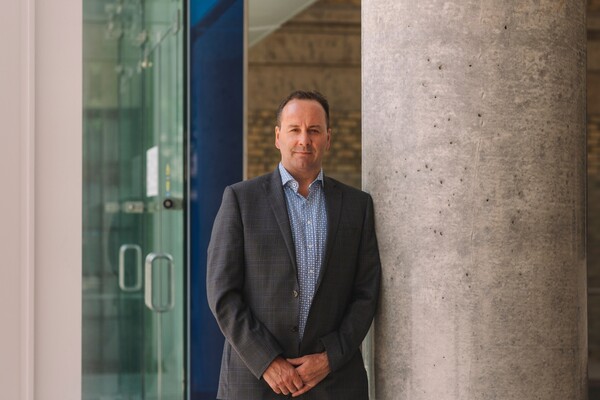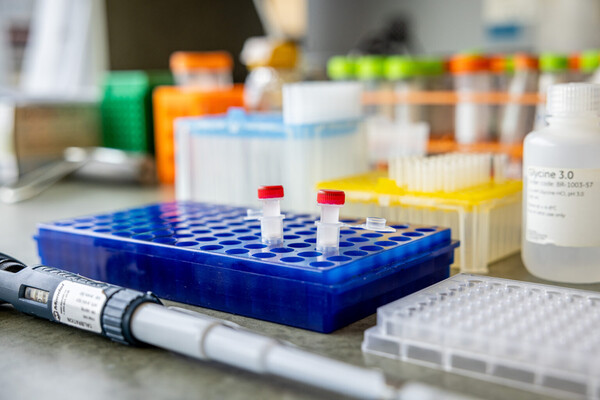Main Second Level Navigation
Donnelly Centre Investigators Win Federal Funding to Build Maps of Cellular Function, Explore New Treatments

Four Donnelly Centre teams have won funding from the federal government to build maps of cellular function at the molecular level and explore new treatments for blindness. The announcement was made earlier this month by the Canadian Institute of Health Research, the principal federal funding agency for biomedical research. Teams led by Brenda Andrews, Charlie Boone, Gary Bader and Molly Shoichet were awarded the total of $4.4M over five years.
“Sustained funding is an essential part of the discovery engine, especially for ambitious long-term projects pursued by Donnelly Centre investigators,” said Stephane Angers, Director of Donnelly Centre and Charles H. Best Chair in medical research. “I congratulate my colleagues for securing these competitive research grants, which will allow them to continue to reveal foundational insights that will underpin medicine of the future.”
Work is already under way in Brenda Andrews’ lab to establish how variation in the genome influences cellular function. Genome sequencing studies have revealed extensive variation among individuals, which is thought to contribute to personal disease risk, but the mechanisms remain unclear. This knowledge gap has impeded the realization of personalized medicine, where disease risk and treatment can be predicted and tailored, respectively, from genome sequence. Andrews, a University Professor of molecular genetics and former director of the Centre, is using Baker’s yeast, Saccharomyces cerevisiae, to address this question. They are investigating how genome variation impacts the basic cellular architecture by looking at dozens of distinct subcellular compartments. A pioneer of large-scale genetics research, Andrews is leading the development of novel approaches which, combined with powerful microscopy and automated image analysis, will enable her team to zoom into and collect data from millions of individual yeast cells to get a population-level view of variation effects on cellular function. Their work will reveal the basic principles governing the outcome of variation to one day guide interpretation of personal genome information for research and in the clinic.
Sustained funding is an essential part of the discovery engine, especially for ambitious long-term projects pursued by Donnelly Centre investigators. I congratulate my colleagues for securing these competitive research grants, which will allow them to continue to reveal foundational insights that will underpin medicine of the future.Stephane Angers, Director, Donnelly Centre
Andrews’ long-term collaborator Charlie Boone, a professor of molecular genetics in the Centre, is addressing the same challenge, but from another angle. The two are globally renowned for their study of genetic interactions in cells, which hold clues to how genes work together, and which are influenced by genome variation. In a previous project that took over 15 years to complete, they took advantage of the experimental tractability of yeast to establish the first global genetic interaction map for any organism, which is also the only complete map available for any eukaryotic cell. In collaboration with Jason Moffat, also a professor of molecular genetics in the Centre, and Chad Myers, a professor of computational biology at the University of Minnesota, they are now building the first reference map for human cells. The resulting network will help reveal which human genes work together to impact cell function and ultimately disease risk. The work involves painstakingly deleting genes from cells, either individually or in all possible pairwise combinations. Two genes are said to interact if the effect of a double deletion is different from that caused by either deletion alone. Because interacting genes tend to be involved in the same cellular processes, the map will also help reveal gene function, which remains unknown for numerous human genes.
Gary Bader’s lab will use the funding to study onset and progression of liver cancer by studying the molecular make-up of individual liver cells during this process. Bader, a professor of molecular genetics and computer science, is a world expert on single-cell transcriptomics, the revolutionary technology that allows scientists to study gene expression in individual cells within a tissue. He is on the Organizing Committee of the Human Cell Atlas, a global consortium that is creating reference maps of human organs at the level of single cells. In 2018, him and his collaborators generated the world’s first map of the human liver. Now they are taking the next step to learn how the various types of liver cells change and interact during cancer induced by Hepatitis B virus. By comparing healthy and diseased livers, they will learn more about which cells are affected and how the disease develops from start to finish. Liver cancer is prevalent in Asia and Africa and on the rise in North America, with few treatment options. The most effective treatment for end-stage disease is liver transplant, but it is expensive and limited by the global scarce supply of donor livers. The insights gleaned will reveal the mechanisms by which liver cancer develops that could be targeted with novel therapies to ideally halt disease progression. Bader’s team includes key collaborators from across disciplines: liver transplant surgeon Ian McGilvray, from the Toronto General Hospital, University Health Network, liver immunologist Sonya MacParland from the Toronto General Hospital Research Institute, UHN, and liver physician and virologist Thomas Michalak from the Memorial University in St. John’s, Newfoundland.
Age-related vision loss is also on the rise in the developed world and Molly Shoichet’s team has spent the last decade developing approaches to combat it. Diseases such as age-related macular degeneration, retinitis pigmentosa, and diabetic retinopathy affect around eight million Canadians. They occur when the photoreceptors, which are the light-sensing cells responsible for vision, die and ultimately result in blindness. Shoichet is a University Professor of chemical engineering and applied chemistry and globally renowned for her research on biomaterial engineering for drug delivery and tissue repair. Building on decades of research in biomaterial design, they have developed a novel hydrogel biomaterial specifically for the eye. They will use it to design a local delivery vehicle for the back of the retina where the photoreceptors reside. Combined with a new method invented in the lab for a sustained release of protein therapeutics, the team aims to rescue vision loss in animal models of blindness. Shoichet is collaborating with the vision researcher Valerie Wallace from the Krembil Research Institute, UHN, with the ultimate goal to advance knowledge towards clinical application.
Follow us on LinkedIn and Twitter to keep up with Donnelly Centre news.
News



